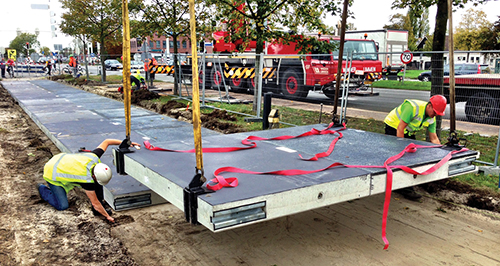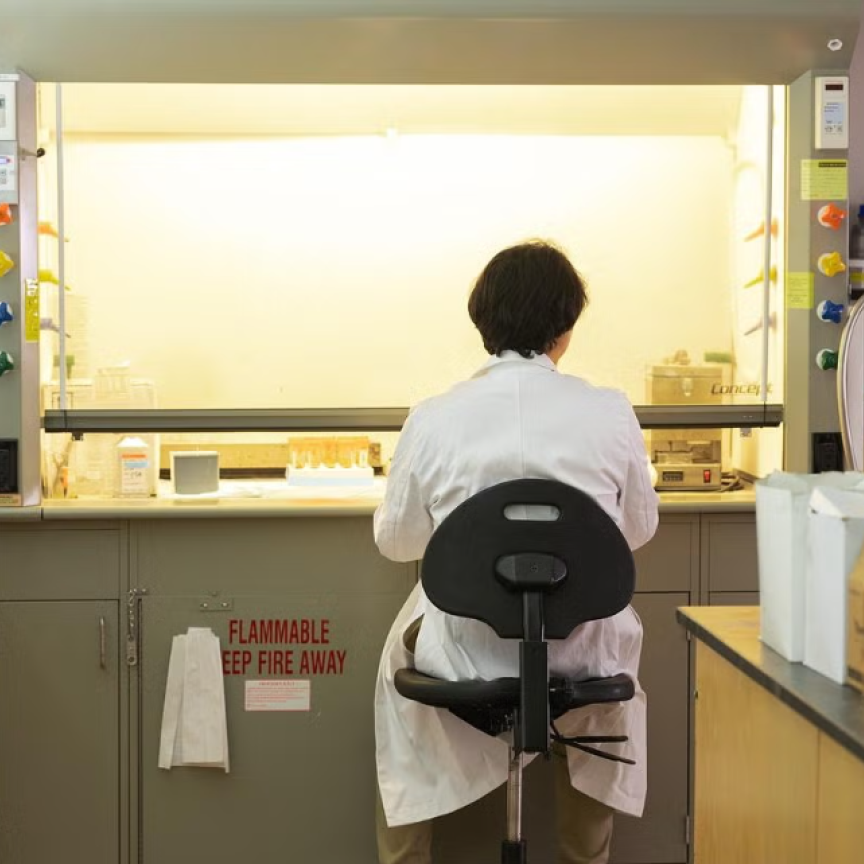Solar energy could so easily meet our ever-growing energy demands – if only we could find a way to capture and utilise the sun’s rays efficiently.
Conventional solar panel technology is a first step towards this goal, but the fabrication and installation of such first-generation photovoltaic devices are often difficult, while concerns over the longevity and efficiency for these devices remain a sticking point in the solar energy sector.
A new generation of photovoltaic technologies could unlock the solar sector’s potential, and it’s a much-needed solution, as Dr Troy Townsend, assistant professor at St Mary’s College of Maryland, explained: ‘Given the projected rise in global population and energy demand, we expect to be using 25 terawatts (TW) as a planet by 2035. Because the sun provides 120,000TW to us every day, we could theoretically harness 600TW if we installed photovoltaics on buildings and roads around the world.’
It’s a tantalising prospect that’s captured the imagination and purse strings of the world’s leading entrepreneurs. Tesla, SpaceX and SolarCity boss Elon Musk, for example, recently unveiled a solar roof made entirely out of solar cells. Exact details on the technology and its cost are yet to be revealed, but it’s just one possibility in the world of alternative solar technology.

Electricity generating SolarWindow
See-through solar
While covering the world’s roofs with photovoltaics will help, another potential application is the incorporation of solar technology into glass.
SolarWindow Technologies is one company working in this area to develop transparent coatings for glass and flexible materials that produce electricity. John Conklin, president and CEO of SolarWindow, said: ‘As a transparent electricity-generating coating, we see SolarWindow coatings being applied to the vast acres of window glass in tall towers and skyscrapers to provide a source of renewable electricity and offset the building’s energy needs in this untapped market.’
These coatings are made primarily of organic compounds, largely composed of carbon, hydrogen, nitrogen, and oxygen. The coatings are applied as ultra-thin layers to create an organic photovoltaic (OPV) device that converts light energy into electricity using the photovoltaic effect.
Electricity is generated as light strikes the layers of a SolarWindow. This light energy moves electrons through the material to the glass surface, then off to the side where it is picked up by the company’s proprietary interconnection system. Conklin added: ‘This allows us to connect the window to other windows to create a modular system, or directly to wires for the transfer of electricity into the building system to provide power for office fixtures and other functions.’
SolarWindow is currently in the process of forming strategic relationships with glass, energy, and building industries, as well as licensing its technology to glass companies already in an existing global market for eventual manufacturing and distribution. Conklin added: ‘Our primary challenges include developing SolarWindow coatings that have high transparency while producing meaningful power, advancing our technology toward product manufacturing, and raising capital to execute our build-out.’
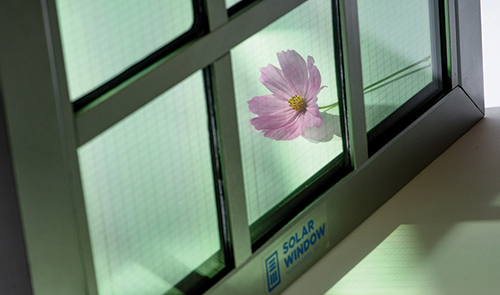
SolarWindow turns solar rays into electricity, making buildings 'power generators'
The technology is close to reaching commercial maturity, as Conklin explained: ‘We are developing our electricity-generating coatings for a variety of products, including large-area glass and BIPV (Building-Integrated PhotoVoltaic) applications in new construction, retrofit, and replacement windows. Our goal is to be ready to move into a commercial-ready product stage by year-end 2017.’
SolarWindow devices have also been undergoing durability tests in an effort to meet or exceed the warranty periods of commercial-grade insulated glass units (IGUs) installed on tall towers. Durability determines product lifecycle, an important feature to the commercial adoption of SolarWindow products for generating electricity on glass windows.
‘We will be performing a number of additional tests to demonstrate reliability, durability, and degradation performance during upcoming phases of product development,’ Conklin said.
‘Our goal is to develop SolarWindow coatings that not only exceed performance of a commercial window warranty, but to be competitive with the performance duration of conventional crystalline silica and thin-film solar PV modules,’ he added.
Walking on sunshine
Urban environments are not just filled with glass-laden buildings; road networks could provide another solar energy opportunity, as Sten de Wit, innovator at solar road specialist company SolaRoad, explained: ‘When we integrate solar technology in roads, the potential for solar electricity production in urban areas will grow substantially without claiming any extra space, without disturbing the environment or nature. [It’s] simply in the roads that we build and use anyway.’
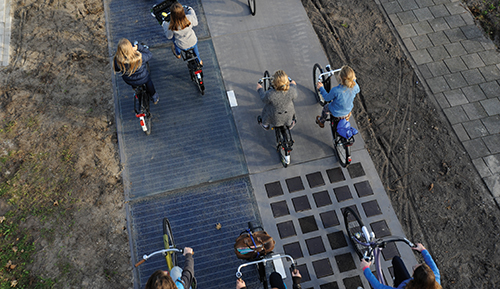
SolaRoad installed its solar bike path in The Netherlands in 2014
The transport of energy is also not an issue with this application, as de Wit added: ‘Moreover, as roads typically connect and cross our built environment where we consume electricity, a solar road network is not only a large scale, but also a decentralised source of green electricity, generating the energy close to where it is consumed.’
SolaRoad has been running a pilot project on a bike road in Krommenie near Amsterdam since 2014. De Wit said: ‘In parallel, we have been developing and improving our technology, with input from the experiences of the pilot. In October 2016, we extended the bike road with the improved technology, to test it in practice. Currently, we are developing towards a product that can be mass produced for large-scale application on bike roads.’
The Netherlands has around 30,000km of bike paths, representing a significant opportunity for solar integration in the future. But in addition to bike paths, SolaRoad is also looking to incorporate the technology into regular roads, according to de Wit: ‘A much larger potential for this technology lies in the application on regular roads. We are currently developing the SolaRoad technology for this purpose. Pilot projects on regular roads are scheduled for 2018.’
Over in France, an experimental solar panel road opened last year in a Normandy village. The trial site incorporates 2,880 photovoltaic panels and the estimated electrical output is 767kWh per day, with peaks of up to 1,500kWh per day in the summer months.
Such pilot sites enable the company behind this technology, Wattway, to keep on improving the panels in terms of cost, explained Philippe Harelle, CTO of Wattway. ‘A cost reduction will especially be possible thanks to the industrialisation of the panels, the mechanisation of the installation and also simpler electrical connections,’ he said.
Wattway uses regular photovoltaic cells that are coated in a multilayer substrate composed of resins and polymers. Any kind of change to standard photovoltaic cells can potentially be coated in this multilayer substrate, making this a highly versatile technology for the photonics sector.
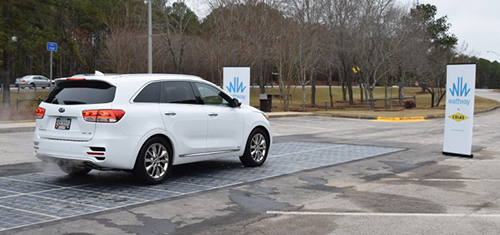
Wattway installed an experimental solar road in Normandy, France, last year
Solar spray
A solar spray is another highly versatile and promising alternative solar technology. Researchers at St Mary’s College of Maryland are developing such spray-on solar cell technology. Dr Townsend said: ‘We envision an inexpensive way of quickly spraying large area solar modules onto roads, roofs, cars, and so on. This would dramatically reduce the price of solar by reducing the installation and fabrication costs, making solar more attainable for the average person.’
The technology uses inorganic materials, as opposed to organic materials usually found in spray and other liquid-based applications. Inorganic materials are typically more stable and have more attractive electro-optical properties than their organic counterparts, hence their widespread adoption in the traditional solar panel sector.
There are issues associated with using inorganic materials in a spray form, as Dr Townsend explained: ‘The major challenge for inorganics is that they – unlike organics – are not soluble in liquid solvents. In order to spray or print inorganic materials, they must either be synthesised as nanocrystal inks or formulated as a combustible salt solution. Both of these end up with an intermediate nanocrystalline film.’
A better device is also usually formed from large crystal grains, as Dr Townsend added: ‘The next challenge will be to find a way to convert these nanometre-sized crystals into micrometre-size grains – which is a 1,000-fold size increase – with enhanced film qualities.’
Another challenge is that the efficiency is limited to between 6 and 12 per cent because of the need for crystal size growth. However, chemists and engineers have recently made great strides with a new type of material known as perovskites. These are metal-organic hybrids that can be solution-processed with minimal heating to produce devices with more than 20 per cent efficiency.
Despite these challenges, solar sprays are a real contender in the alternative solar space thanks to the stability of the technology. ‘Our sprayed nanocrystal devices last for several years and show little signs of degradation because they are inherently stable,’ Dr Townsend said.
‘While there are still lingering stability issues with this technology, many companies are emerging right now to take this to market because of the efficiency and the solution processing capability. Research is currently focused on improving the air stability of the layers and the device encapsulation to prevent water exposure.’
The research has also recently transitioned to nanodevices, and this poses new challenges and opportunities for photonics companies, as Dr Townsend explained: ‘Our devices, for example, are less than one micrometre thick, which is 50 times thinner than the human hair. This leads to ultra-thin and lightweight devices that can be deposited cheaply and quickly. Not only would this save money on materials used, but would also open new applications to start thinking about where we could deposit these devices and how many we could pack into a smaller area. This includes LEDs and transistors, which are also thin film layered electronics.’
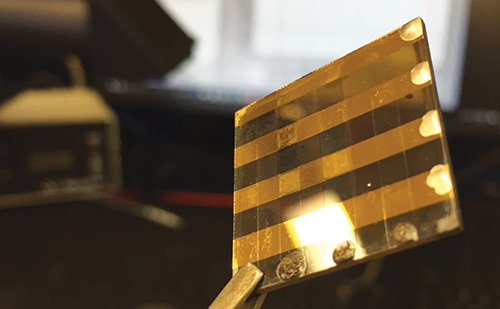
Spray-on inorganic nanocrystal test device
Solar foliage
Taking inspiration from nature, the Noël research group at the Eindhoven University of Technology has developed a ‘solar leaf’ technology to harvest the sun’s light. Timothy Noël, assistant professor at Eindhoven University of Technology, explained: ‘We looked at nature’s biomachinery – leaves, bacteria, algae. These organisms harvest light very efficiently by capturing the light with so-called antenna molecules. Next, the light is brought to the reaction centre where the actual photosynthesis process occurs.’
The solar leaf device does something similar: it captures solar energy, changes the energy form to match it with the needs of a specific reaction, and also directs that light to the reaction channels where the reaction takes place. ‘Consequently, we can absorb much more light than a traditional photoreactor, as up to seven times more photons hit the reaction channels,’ Noël added.
Energy efficiency challenges remain and the group has developed a ray-tracing model to determine the fate of every photon hitting the device. This should help improve the device’s performance over the next few years, according to Noël.
He added: ‘For scalability, we are using a numbering up strategy. Simply said, that is copy pasting the device until you have enough throughput. So actually, you are placing many devices in parallel to reach the required production capacity. Here, the challenge is to make sure that every device performs in exactly the same way. We are close to finalising this work and submitting it for publication.’
The research is in the early stages, but the team did not patent this technology in order to speed up its development. Noël said: ‘I am an idealist and I want to help people with my inventions. So, my hope is that it will be used in those regions where there is no access to a power grid, for example, in Africa, deserts, war zones, even in space.’
Uncertain future
Unfortunately, the current political climate does not match these ideals. Noël added: ‘It seems some politicians do not want to listen at all, despite the overwhelming evidence – look at the newest worrying evolutions in the USA. So, we as people and scientists should take action and continue working on the use of renewable energy sources.’
It is hoped that the economic need and benefits of alternative solar technologies will shine through, as Conklin of SolarWindow explained: ‘As policies are implemented in the future, we will assess their effects on the solar industry, but I believe President Trump will ultimately rely and build on his foundation of economic principles, and recognise the importance that renewable energy represents in terms of a growth economy, energy and infrastructure, and job creation.’
De Wit of SolaRoad added: ‘Solar energy is not only a solution for carbon emissions reduction, it is also good business as solar starts to deliver electricity at price levels that can compete with electricity from fossil fuels. And the costs of solar keep falling. The plans of the US administration to make large investments in infrastructure can offer interesting opportunities for solar pavements, which are cheaper than regular pavement over the life cycle.’
Photonic factors
For alternative solar applications to reach full commercial maturity and offer a significant business opportunity to open the eyes of current high-profile political figures, they need to realise improved material efficiencies.
This is where photonics companies can help, as Rob Morris, marketing manager at Ocean Optics, explained: ‘Ultimately, solar technologies are about gaining the maximum efficiency from the solar storage media, for the least cost. Optical sensing technologies help manufacturers refine different elements of their products.’
Morris said: ‘There are several types of spectroscopy measurements that can be performed – applications such as measuring the transmission efficiency of panel materials, performing QC [quality control] on the solar flashers that are used for panel testing, and using endpoint detection techniques to monitor coatings, thickness and the like. Each customer has slightly different needs, but some process applications can be challenging, and some testing environments can test the performance limits of the spectrometers used for testing,’ he added.
In other words, alternative solar represents a huge commercial opportunity for the photonics industry. If companies can tap into this emerging market, work with the diverse range of applications leaving the world’s research institutions, and answer the challenges it presents to the renewable energy sector – there could be light at the end of the tunnel.
